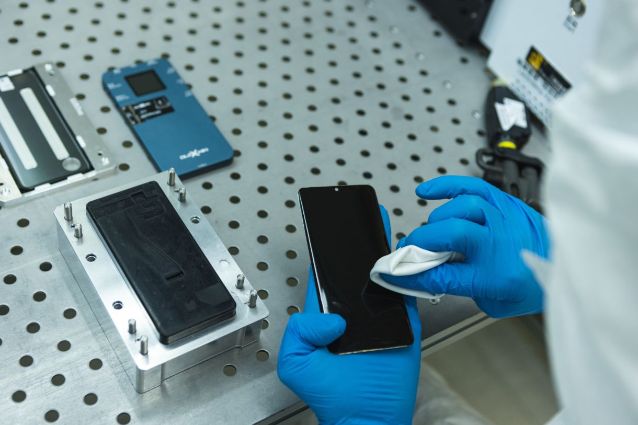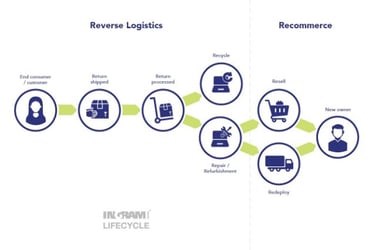90% of the adult world population owns a mobile phone. We’ve become ever-more reliant on them as a trusted form of communication. Inevitably, your device will no longer serve the function you’ve come to expect.
International E-Waste Day takes place every year on October 14th. It serves as an international reminder of how electronic waste negatively impacts the environment. Consider that the global population is over 7 billion people and that 90% of them own a mobile phone. Some will use more than one. There may be additional handsets lying discarded in drawers.
Although Ingram Micro Lifecycle works to extend the lifecycle of devices, it’s inevitable that your smartphone will eventually need replacing. Through our repair and refurbishment services, we strive to salvage usable and functional devices so they hold value for longer and avoid becoming waste for as long as possible. Our innovative processes, such as LCD repair, combine technologies to offer cost-effective alternative solutions that reduce the costs of restoring pre-loved devices.
Here are the top factors to consider when the time comes and you’re thinking of getting rid of your current device, or one you’ve had stashed in a drawer as a backup.
Someone’s trash is another’s treasure
The device you’re looking to get rid of may not be useful to you, but it could be just what someone else is looking for. Demand for pre-loved, refurbished devices is growing at a time when phrases like ‘cost of living crisis’ force us to evaluate what we deem as necessary expenditure.
If your company has a bundle of unwanted devices, look for buy-back schemes.
The device you no longer want could be a lifeline to someone else. Constricting budgets means some people cannot afford the increasing big bucks for brand-new handsets.
Even if the device doesn’t work, or has some damage, the parts could be salvaged to be used in similar devices to give others a new lease of life. To enable this, you need to trade in your device to…
Get money back?
That’s right. Any devices you don’t want could still be worth some money. Repair and refurbishment services can smooth away any tarnishes that make your device unwanted and like-new for the next user.
Trade-in schemes are becoming ever-popular as a way for people to make money back on their unwanted devices. If you like getting a fresh new handset regularly, you can consider trading in your current device for money off your new one. Or you can trade in an unwanted device for cash.
Your used handset will be graded by the trade-in partner. If feasible, they will put it out to the secondary market for re-use. If it can’t be cost-effectively repaired, the parts will be harvested and any waste responsibly recycled.
This is a great way for businesses to recover money on technology that otherwise depreciates, especially in a market when new models are on a regular release schedule. The money recovered from unwanted smartphones can be funneled back into the purchase of new ones or put into other areas of IT, like data security.
But wait, money back for something you don’t want anymore. There has to be a catch, right?
No! There isn’t. Just be sure you…
Use a reputable provider
Whether you’re looking to trade in your handset or recycle it, be sure the company you turn to is responsible. Research beforehand and check what processes they employ for handling used devices. Most network operators run a trade-in program.
Under the Basel Convention, it’s illegal to export electronic waste internationally. Look out for what certifications for recycling and waste management the company holds. Certifications and accreditations are also important when it comes to handling your data.
Protect your data
When your device moves outside your responsibility, be cautious that whatever data resides on it could reappear.
Information stored in apps, saved passwords, and photos can be accessed if not properly removed.
In the first instance, you can do a factory reset. To be extra sure, whoever you trade in or recycle with should hold OEM (Original Equipment Manufacturer) accreditations. These accreditations are a mark of trust that the partner operates to the approved manufacturer processes.
For example, a company with a Samsung accreditation will have access to Samsung’s approved software, repair manuals, guides, processes, and more. You’ll know that if you’re trading in or recycling a Samsung device, the partner is well-equipped to handle it.
It’s in the company’s best interests too, because it could mean huge financial repercussions for them if they’ve played a part in personal or company data being leaked.
Responsibly free yourself of unwanted smartphones
Reduce your e-waste contributions by ensuring that any devices you no longer want don’t just go into the bin with cables and earphones. Consider the factors above and take your device for recycling or refurbishing.
Ingram Micro Lifecycle supports businesses around the globe with trade-in programs, buy-back schemes, and with repair and refurbishment processes. For decades, we have responsibly and cost-effectively extended the lifecycle of IT, mobility, and electronic equipment. We have the agility and global footprint to scale and develop processes that keep up with innovation, easing the pressure on you.
Get in touch today to discuss how we can help your business enable a circular economy and reduce your e-waste contributions through trade-in and buy-back programs.
Recommended further reading:













